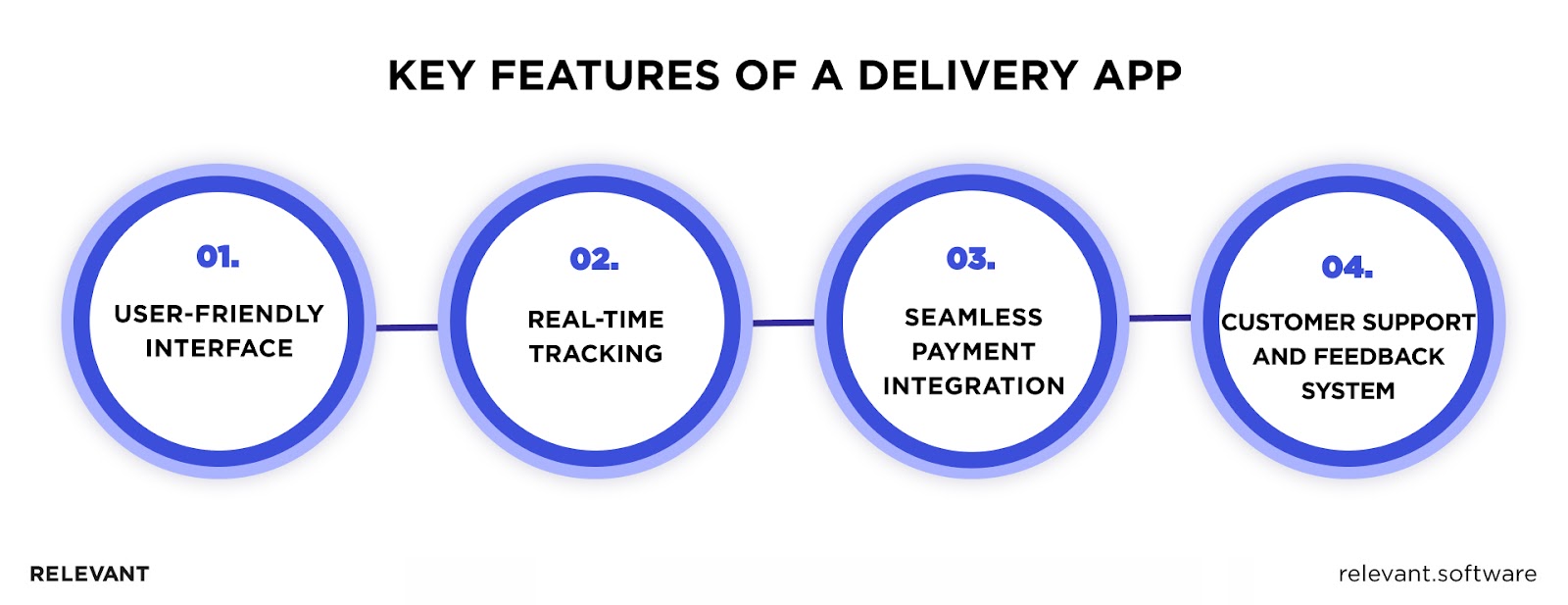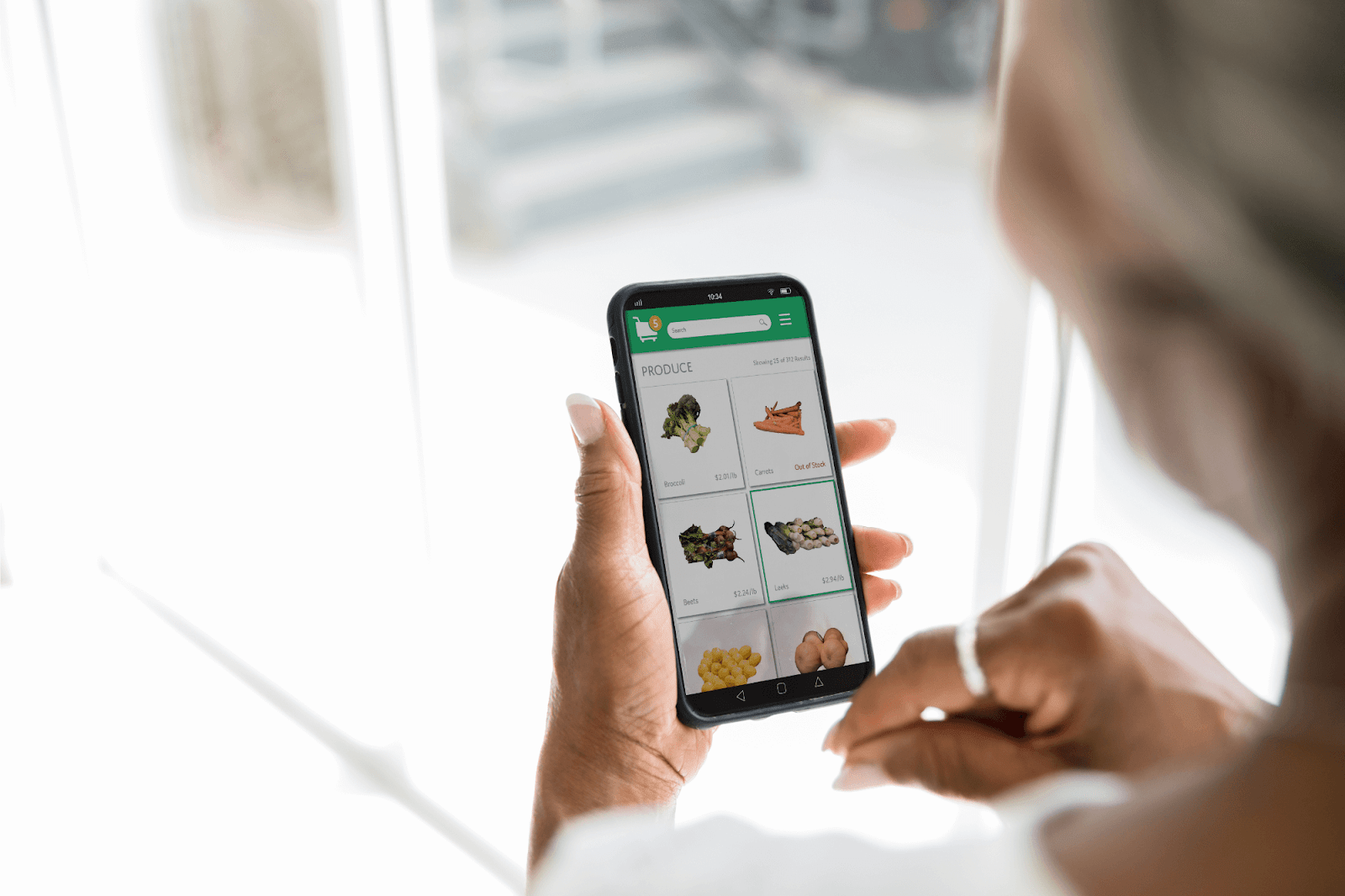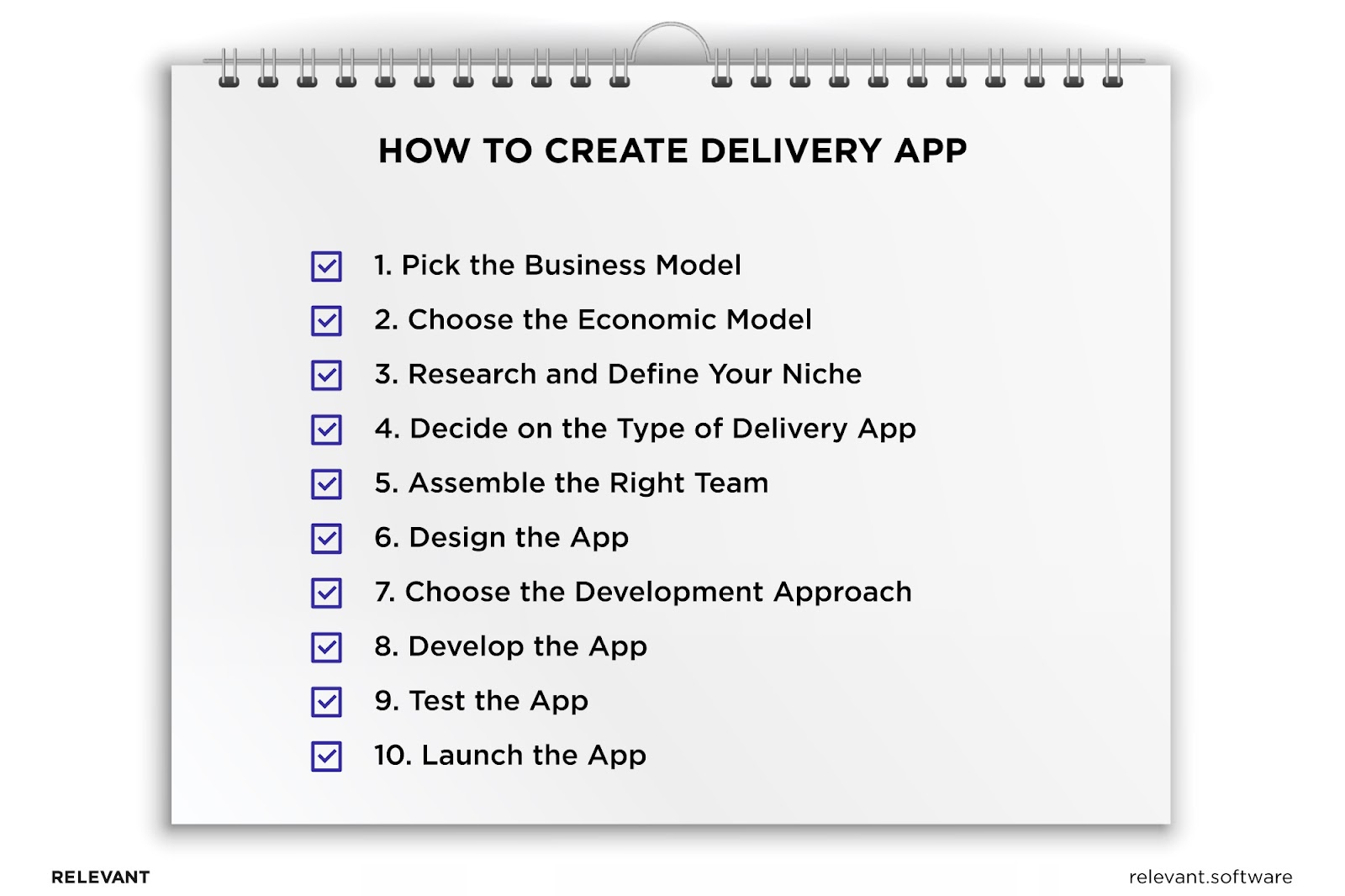How to Create a Delivery App and Succeed

These days, it feels like almost anything can land on our doorstep with just a few taps on our phones. This bustling scene in delivery app development? It’s just a digital reflection of our always-on, connected lives.
Now, you might be pondering, “How to create a delivery app that really pops in a sea of established giants?” Sure, it’s a crowded space, but remember, there’s always a corner for fresh ideas and even better service. Just think, every app that’s now a household name began as a lightbulb moment, spotting a need or fixing a pain point.
In this piece, we’re not just going to give you a dry run-through of the steps to build a delivery app. Honestly, that part’s more straightforward than you might think. The real crux of the matter, and where we’re zooming in, is how to pack your app with so much value that users don’t just download it but love it, use it, and tell their friends about it.
The Booming Delivery App Industry
For those eyeing the delivery app market, here’s a slice of great news: the opportunity is enormous. Why’s that? Well, online food delivery is on a meteoric rise. We’re talking about a projected revenue surge of 13% yearly from 2023 to 2027, soaring to a staggering $1.65 trillion by 2027. And grocery delivery? It’s skyrocketing. Predictions for 2024 show a global growth of 22.2%, with a whopping 29% jump in the U.S. This boom could mean traditional grocery stores might just have to tip their hats to their digital contenders.
Picture this: by 2027, about 2.5 billion people globally will be ordering meals online, with an impressive 1.6 billion in Asia alone. In the app world, giants like Zomato, Uber Eats, and Swiggy racked up tens of millions of downloads in 2022. DoorDash? It’s a hit in the U.S. with 22 million downloads, not to mention its global appeal with 27 million downloads. This trend underscores the escalating relevance of food delivery services across the globe.
Essential Features of a Delivery App
Creating a delivery app is like crafting a recipe; you need the right ingredients for it to be a hit. But here’s a little reality check – it’s not just about how to create a delivery app; it’s about filling a gap, solving a problem, and making people’s lives easier. That’s the recipe for success in this bustling industry. Here’s what’s essential:

User-Friendly Interface
First things first, your app should be easy to use. Imagine your user is in a rush, hungry, or just not tech-savvy. Your app needs to be so straightforward that even your grandma can use it without calling you for help. Big buttons, clear options, and a simple layout – that’s the key. No one likes to tap around a maze.
Real-time Tracking
Now, who doesn’t like to know where their order is? It’s like a mini adventure on your phone. With real-time tracking, users can see their delivery journey from the store to their doorstep. It’s not just about waiting; it’s about watching the journey unfold, which somehow makes the wait less annoying.
Seamless Payment Integration
Let’s talk payments. They should be as smooth as swiping right on your favorite dating app. Whether it’s credit cards, digital wallets, or cash on delivery, offer options and make it secure. No hidden fees jumping out at the last moment! Remember, a clunky payment process is like hitting a speed bump at full speed – nobody enjoys it.
Customer Support and Feedback System
Wrapping up our deep dive into delivery app essentials, let’s not breeze past the vital role of customer support and feedback systems. Give your users a voice. Whether they’re singing praises or voicing grievances, a robust feedback mechanism is like your digital open door. It’s all about making your users feel seen and valued. And when the going gets tough (because, let’s be real, it sometimes does), your support squad should be on standby, ready to turn those frowns right side up.
So, there’s your recipe for a winning delivery app: a user-friendly interface, on-the-dot tracking, hassle-free payments, and, of course, rock-solid support. Nail these, and your app transforms from just another app to a daily lifesaver, a trusty pal in this bustling digital universe.
Main Types of Delivery Apps
You’ve probably got a few of these apps on your phone right now. Each type serves a unique purpose, making our digital lives a little more convenient. Let’s unpack what sets each apart and the keys to developing them.
Food Delivery Apps
Picture the last time you used an app to order pizza. The app offers you an assortment to choose from, pinpoints your location, and lets you track the delivery in real-time. That’s the sort of seamless experience, combined with savvy GPS integration and a solid payment setup, that defines a top-tier food delivery app. And don’t forget about handling the dinner rush and weaving in those ever-important user reviews.
Grocery Delivery Apps
Grocery delivery app development is playing a different game. It’s like being a virtual shopping cart that knows exactly what’s in stock and where. This calls for a deep understanding of local supply chains and crafting an interface that’s as natural as strolling through the supermarket.

Package and Courier Delivery Apps
This area is all about the magic of logistics and finding the best delivery routes. The challenge for dedicated developers? Crafting algorithms that balance speed and cost-effectiveness. Add to that the need for real-time tracking, secure transactions, and a system agile enough to handle packages of all shapes and sizes.
E-commerce Delivery Apps
Now, e-commerce apps, they’re the bustling marketplaces of the digital world. Your job is to make sure that a virtual shopping cart translates into real smiles. Keep it slick, secure, and savvy. Remember, in the world of clicks and carts, a smooth return policy is as important as a speedy checkout.
On-demand Service Delivery Apps
Whether it’s fixing a leaky tap or booking a haircut at home, these apps need to be a Jack of all trades. On-demand food delivery app development should let you book a service, chat with the provider, and pay for it, all without leaving the app.
Ride-Sharing and Ride-Hailing Apps
Move over, traditional taxis. These apps offer a quick, convenient, and often more affordable way to get around. They must have geolocation services, a foolproof system for calculating fares, and features that make every passenger feel safe and every driver feel heard.
Medicine Delivery Apps
Tread carefully; in medicine delivery app development, you’re dealing with health. This is about getting the right meds to the right person at the right time. Compliance and privacy are your watchwords. Think of it as a digital bridge between the pharmacy and the bedside.
Alcohol and Beverage Delivery Apps
Cheers to making happy hours happier! But remember, with great beverages come great responsibilities – age checks and local laws are your guardrails. Your alcohol delivery app development should be like the best bartender: knowledgeable, efficient, and always law-abiding.
Each of these app types has its own nuances in development, targeting a specific market need. This means that the journey of creating each app is as unique as the service it offers. From the user interface that captures the user’s attention to the intricate back-end systems that ensure smooth operation, every aspect needs to be tailor-made.
How to Create Delivery App: Steps to Go
Let’s talk about delivery app development. It’s not rocket science, but it sure needs a good mix of planning, technical savvy, and a pinch of creativity. But before diving into the design and software development process, it’s crucial to choose the right business model for your delivery app. This decision will shape your app’s future.

1. Pick the Business Model
Think of your business model as your strategy playbook. It will determine how your application will perform in the real world.
B2B Delivery App Business Model
You’re looking at serving other businesses here. Think of Cargomatic – they’re all about logistics.
- Pros: Bulk orders can help you scale up fast. It’s like hitting the gas pedal on a highway.
- Cons: Quality is your bread and butter for repeat business. Plus, figuring out how to make money can be a bit of a head-scratcher since you’re dealing with invoices, not direct sales.
B2C Delivery App Business Model
This one’s about connecting directly with customers. Picture the Starbucks app, where folks line up their coffee orders for pickup.
- Pros: You can skip the middleman, meaning no extra fees. It’s a straight road from you to the customer.
- Cons: Getting a large customer base is a slow climb. It’s like planting a garden – you need patience and care.
Three-sided Delivery App Business Model
Here, you’re juggling a lot. It’s like Uber Eats with its spectrum of restaurants and delivery choices.
- Pros: You grow quickly and offer a buffet of options, tempting more customers.
- Cons: You’re up against dedicated B2C apps, which might undercut you on price.
So, before you jump into the app-making arena, take a moment. Choose your business model wisely – it’ll set the stage for everything your app becomes. Remember, in the app world, just like in cooking, starting with the right base makes all the difference.
2. Choose Your Economic Model
Choosing the right monetization strategy is like picking the right gear for a road trip; it determines how smoothly you’ll ride to your revenue destination.
- Commission: Think of this as a matchmaking fee. Every time your app connects a customer with a service, you get a cut from both sides. It’s a classic win-win.
- Delivery Fee: This one’s straightforward. For every delivery made, a small fee is added. It’s like paying for the convenience of doorstep service.
- Pass Fee: Here, users pay a regular fee, say monthly, and in return, they get perks like discounts or exclusive offers. It’s like a club membership – the more they use it, the more they save.
- Ads: Got space in your app? Rent it out to advertisers. It’s like having billboards in a digital world, and you earn every time someone sees or clicks.
- Partnership Fees: This is about teaming up with other businesses and featuring them on your platform. Think of it as charging for a VIP spot in your app.
Selecting how you’ll make money is as crucial as the app itself. It lays down the foundation, giving you a clear path for development and growth.

3. Research and Define Your Niche
When you’re setting out to build a delivery app, think of it as embarking on a culinary adventure. You’ve got to pick your main ingredient – your niche. Is it food, groceries, flowers? Dive deep to really get the essence of your chosen area. You’re not just whipping up another app; you’re filling a gap in people’s lives.
4. Decide on the Type of Delivery App
What’s the recipe for your app going to be? A simple, single-focus app or a versatile multi-service platform? This choice is like picking your cuisine – it defines everything from the ingredients (key features) to the kitchen equipment (tech stack) you’ll need.
5. Assemble the Right Team
Are you going to cook this meal at home (in-house development) or call in a caterer (software development outsourcing)? Each choice has its own flavor and cost, so choose wisely.
6. Design the App
Now, start working on UI/UX design, wireframing, and prototyping. It’s not just about making the app look good; it’s about crafting a user experience that’s as satisfying as your favorite dish.
7. Choose the Development Approach
Native or cross-platform? It’s like choosing between making a sauce from scratch or using a pre-made base. Native is tailored but takes more time, while cross-platform can be a quicker route but with less customization.
8. Develop the App
Here’s where your app starts simmering on the stove, with front-end and back-end development. You’re combining all the ingredients – your features – to create something that tastes just right.
9. Test the App
You wouldn’t serve an undercooked meal, so don’t launch an under-tested app. Alpha, beta, load testing – it’s your taste test to ensure every bite (or click) is perfect.
10. Launch the App
The grand opening! Launching your app is like the ribbon cutting of your new restaurant. It’s exhilarating, a bit nerve-wracking, but definitely a moment to savor.
Building a delivery app is a journey, from the first spark of an idea to the day you see it live on the app store. It’s your creation, your digital offspring. Give it the care it deserves!
Summary
As we wrap up our guide to creating a successful delivery app, let’s not forget the experts who bring these ideas to life. For example, our team of experienced developers and UX designers doesn’t just come up with apps; we build digital bridges between businesses and their customers.
How do we work? We tune into your vision, sprinkle in our know-how, and together, we whip up something that’s not just unique but downright memorable. Armed with a deep-seated knowledge of app development and a keen eye on what’s buzzing in the tech world, we ensure your app is more than just a face in the digital crowd.
So, when you’re all set to breathe life into your delivery app dream, contact us. Let’s team up and create something extraordinary.



